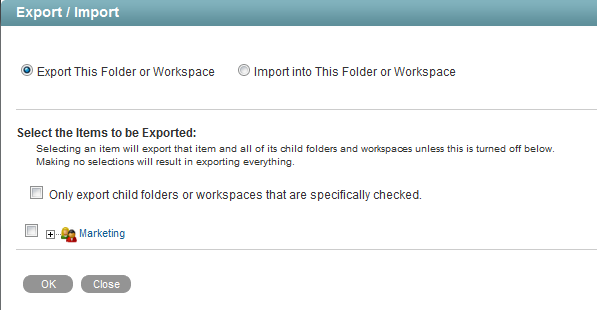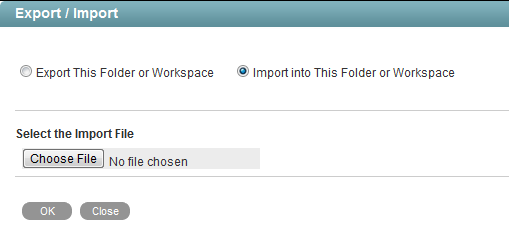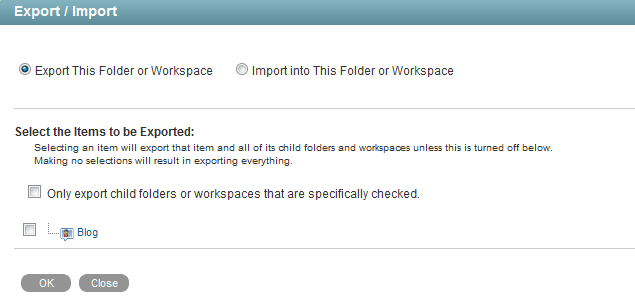21.1 Exporting/Importing Workspaces, Folders, and Entries
You can transfer data from one Novell Vibe site to another by exporting it from the source Vibe site and importing it into the destination Vibe site. When you export data, it remains in the source Vibe site and a copy of the exported data is imported into the destination Vibe site.
By default, only the Vibe administrator can export and import workspaces, folders, and entries. For information on how to make this functionality available to all workspace and folder owners, see Section 2.7, Enabling Users to Import and Export Workspaces, Folders, and Entries.
If you want to simply move or copy data within a single Vibe site, see Copying a Workspace
and Moving a Workspace
, Copying a Folder
and Moving a Folder
, or Copying a Folder Entry
and Moving a Folder Entry
in the Novell Vibe 3.4 User Guide.
21.1.1 Understanding the Export and Import Process
The export process creates a .zip file named export.zip that you can save to any convenient location on disk. The .zip file contains all the workspaces, folders, folder entries, and attachments that you elected to export.
When you export and import a workspace, folder, or folder entry, not all types of data are preserved.
Data That Is Preserved
-
Hierarchical structure of the workspace
If you are selecting specific folders within the workspace to export, the hierarchical structure to the selected folders must be preserved. For example, if you select to export a sub-folder but not the parent folder, the parent folder is also included in the export as a blank folder in order to keep the structure.
-
All folders in the workspace (unless they are specifically excluded)
-
All content in exported folders
-
Access control information
User and group IDs are also preserved and are matched to the same users and groups if they exist on the Vibe system where the workspace, folder, or entry is imported.
Access control settings are not preserved if the workspace, folder, or entry is inheriting its access control settings from the parent folder or workspace in the original Vibe system. When you import a workspace, folder, or entry that is inheriting its access control settings, the workspace, folder, or entry assumes the access control settings of the higher-level workspace or folder where it is being imported. For more information on access control, see Section 2.0, Planning and Controlling User Access to Workspaces and Folders.
-
Landing pages for workspaces or folders
For more information on landing pages, see
Creating and Managing Landing Pages
in the Novell Vibe 3.4 Advanced User Guide. -
Entry definitions associated with any folder content
Entry definitions are custom entry forms that have been created in your folder or workspace. Entry definitions that are being used in any exported content are preserved, even if the definition is saved at a higher level in the workspace hierarchy. For more information on entry definitions, see
Designing Custom Folder Entry Forms
in the Novell Vibe 3.4 Advanced User Guide. -
Workflows associated with any workspace content
Workflows that are being used in any exported content are preserved, even if the workflow is saved at a higher level in the workspace hierarchy.
NOTE:If your workflow contains an On Entry condition that starts a parallel workflow thread, as described in
Adding On-Entry or On-Exit Events
in the Novell Vibe 3.4 Advanced User Guide, the parallel workflow is automatically restarted when the workflow is imported.For more information on workflows, see
Creating and Managing Workflows
in the Novell Vibe 3.4 Advanced User Guide. -
Custom forms associated with any workspace content
Custom forms that are being used in any exported content are preserved, even if the custom form is saved at a higher level in the workspace hierarchy.For more information on custom forms, see
Designing Custom Folder Entry Forms
in the Novell Vibe 3.4 Advanced User Guide. -
Wiki links
For more information on wiki links, see
Linking to a Folder or Folder Entry
in the Novell Vibe 3.4 User Guide. -
Content in Mirrored Files folders
When you export a Mirrored Files folder, the files from the mirrored folder are written in the export file. However, when the folder is imported, the resulting folder becomes a Vibe library folder where all the files are added as regular file entries that are no longer mirrored. There is no way to export a mirrored folder and import it back into Vibe as a mirrored folder.
Data That Is Not Preserved
The following types of data are not included in the export and import processes:
-
Profile information for user workspaces
When a user workspace is exported and imported, the profile information for the user is not preserved. To move user workspaces from one Vibe site to another, add users to the target Vibe server in one of the ways described in Section 5.1, Adding New Users to Your Vibe Site. You can then export the folders within the workspace from the source Vibe site, then re-import the folders into the target Vibe site to the user workspace for each appropriate user.
-
Accessories
For more information on accessories, see
Managing Accessories
in the Novell Vibe 3.4 User Guide. -
Custom JSP files
Custom JSP files must be exported as part of an extension. (For more information on extensions, see Section 14.0, Adding Software Extensions to Your Vibe Site.) However, if you have a workspace that leverages custom JSP files, the workspace still retains the settings that point to the custom JSP files. Therefore, if you export a workspace or folder that is referencing custom JSP files, and the Vibe site where you import the workspace has the same custom JSP files, the imported workspace or folder points to the correct custom JSP files.
-
Permalinks
Entries that are exported receive new permalinks when they are imported. However, if an entry description contains a permalink to another entry that was also imported, then the permalink is preserved.
-
Activity data, such as who visited the place, edit history, and workflow history
For more information about activity data, see
Generating Activity Reports for a Workspace
,Generating an Activity Report on a Folder
, andGenerating Reports about a Folder Entry
in the Novell Vibe 3.4 User Guide. -
Entry ratings
For more information on entry ratings, see
Rating a Folder Entry
in the Novell Vibe 3.4 User Guide. -
Entry definitions that are not associated with folder content
Entry definitions are custom entry forms that have been created in your folder or workspace. For more information on entry definitions, see
Designing Custom Folder Entry Forms
in the Novell Vibe 3.4 Advanced User Guide. -
Workflows that are not associated with workspace content
For more information on workflows, see
Creating and Managing Workflows
in the Novell Vibe 3.4 Advanced User Guide. -
E-mail notification settings
-
Default folder columns
-
Global filters
21.1.2 Exporting Workspaces
-
Log in to the Vibe site as the Vibe administrator.
-
Navigate to the workspace that you want to export.
-
Click .
The Export/Import page is displayed.

-
Select .
-
To export all contents of the folder or workspace, click .
or
To export only individual workspaces and folders, select , then expand the workspace tree and select the workspaces and folders that you want to export. Then click .
21.1.3 Importing Workspaces
-
Log in to the Vibe site as the Vibe administrator.
-
Navigate to the workspace where you want the imported workspace to reside.
-
Click .
The Export/Import page is displayed.
-
Select .

-
Browse to and select the workspace that you want to import, then click .
21.1.4 Exporting Folders
-
Log in to the Vibe site as the Vibe administrator.
-
Navigate to the folder that you want to export.
-
Click .
The Export/Import page is displayed.

-
Select .
-
To export all contents of the folder or workspace, click .
or
To export only individual workspaces and folders, select , then expand the workspace tree and select the workspaces and folders that you want to export. Then click .
21.1.5 Importing Folders
-
Log in to the Vibe site as the Vibe administrator.
-
Navigate to the folder or workspace where you want the imported folder to reside.
-
Click if you are importing into a folder.
or
Click > if you are importing into a workspace.
The Export/Import page is displayed.
-
Select .

-
Browse to and select the folder that you want to import, then click .
21.1.6 Exporting Folder Entries
-
Log in to the Vibe site as the Vibe administrator.
-
Navigate to and select the folder entry that you want to export.
-
In the entry footer, click .
You can now download the entry to your computer’s file system.
21.1.7 Importing Folder Entries
-
Log in to the Vibe site as the Vibe administrator.
-
Navigate to the folder where you want the imported folder entry to reside.
-
Click .
The Export/Import page is displayed.
-
Select .

-
Browse to and select the folder entry that you want to import, then click .